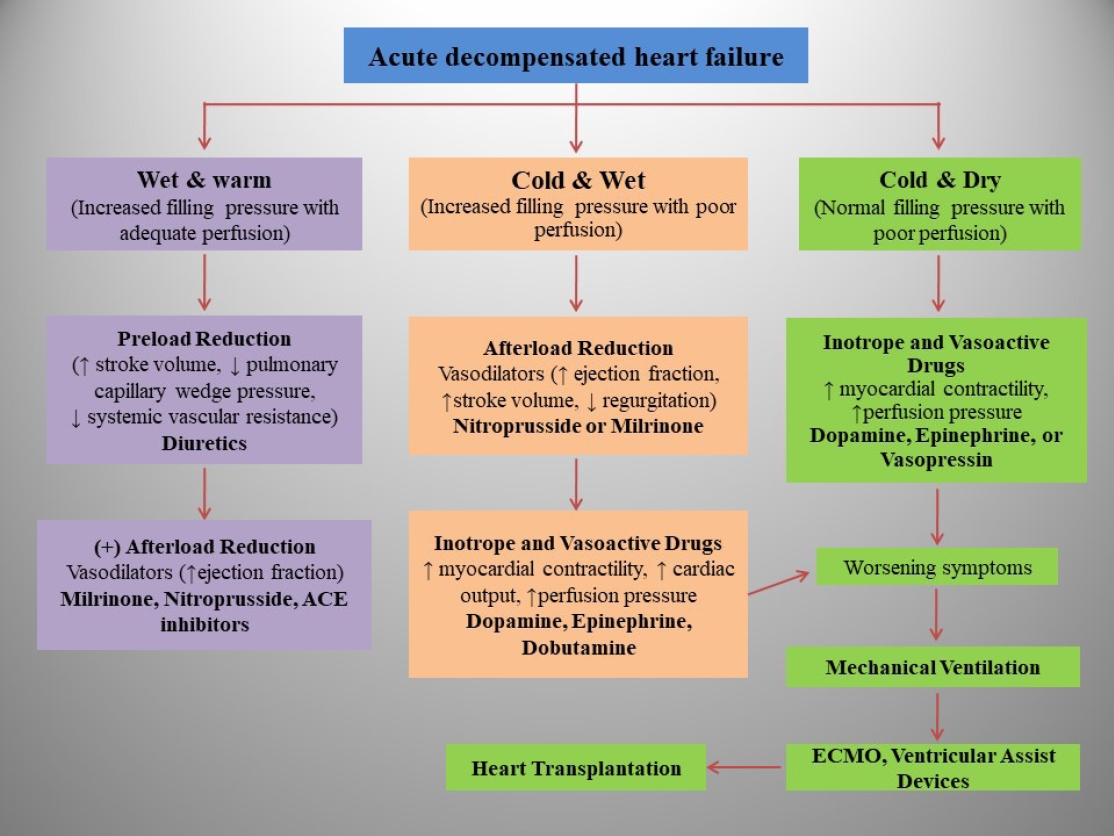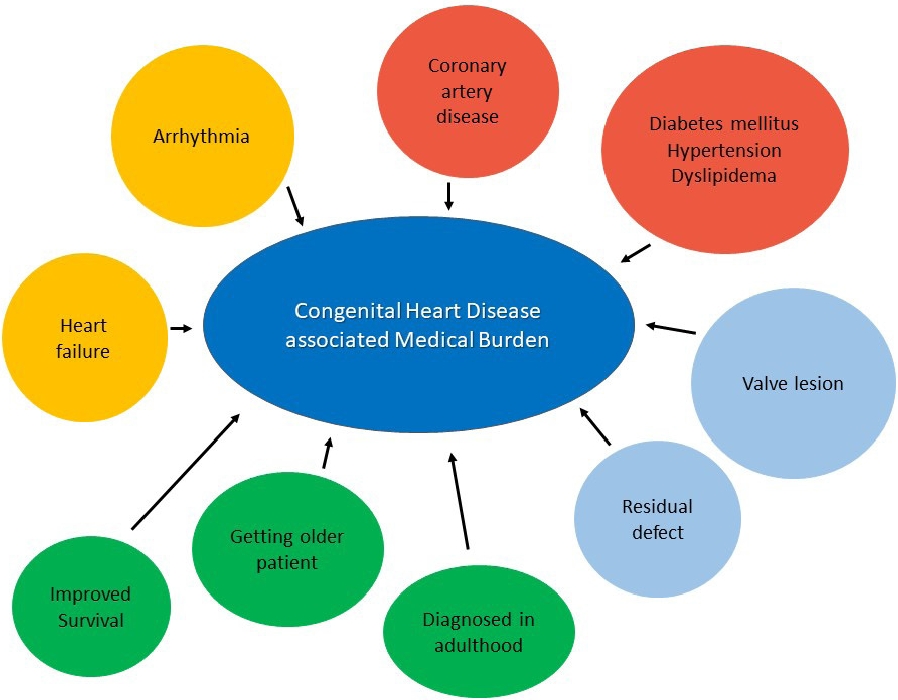Search
- Page Path
-
- HOME
- Search
- Review Article
- Cardiology
- Heart failure in children and adolescents: an update on diagnostic approaches and management
- Amit Agrawal, Dalwinder Janjua, Abdulrahman Ahmed Alsayed Ali Zeyada, Ahmed Taher Elsheikh
- Clin Exp Pediatr. 2024;67(4):178-190. Published online June 19, 2023
-

· Pediatric heart failure (PHF) is a clinical syndrome featuring various symptoms (shortness of breath, ankle swelling, fatigue) and signs (pulmonary crackles, peripheral edema).
· Congenital heart diseases are the most common underlying etiology of PHF, whereas myocarditis and primary cardio-myopathies are common in children without structural ab-normalities.
· PHF pathophysiology is complex and multifactorial and varies by etiology and age.
· PHF management includes decongestive therapy, treatment of underlying causes, preventing progression, and managing pulmonary or systemic obstructions.
· Drugs should be chosen based on pharmacodynamics, clinical manifestations, hemodynamic state, and renal function.
- Environmental changes surrounding congenital heart disease
- Eun-Young Choi
- Clin Exp Pediatr. 2023;66(8):332-338. Published online January 2, 2023
-

· As the number of patients with congenital heart disease increases, the medical burden increases.
· Various fusion imaging techniques using percutaneous procedures have been introduced.
· With advances in technology, convenient ambulatory devices have been introduced.
· A well-organized team approach is required to resolve advanced heart failure in patients with congenital heart disease.
- Pulmonary stenosis and pulmonary regurgitation: both ends of the spectrum in residual hemodynamic impairment after tetralogy of Fallot repair
- Byung Won Yoo, Han Ki Park
- Clin Exp Pediatr. 2013;56(6):235-241. Published online June 21, 2013
-
Repair of tetralogy of Fallot (TOF) has shown excellent outcomes. However it leaves varying degrees of residual hemodynamic impairment, with severe pulmonary stenosis (PS) and free pulmonary regurgitation (PR) at both ends of the spectrum. Since the 1980s, studies evaluating late outcomes after TOF repair revealed the adverse impacts of residual chronic PR on RV volume and function; thus, a...
- Right ventricular failure in congenital heart disease
- Young Kuk Cho, Jae Sook Ma
- Clin Exp Pediatr. 2013;56(3):101-106. Published online March 18, 2013
-
Despite developments in surgical techniques and other interventions, right ventricular (RV) failure remains an important clinical problem in several congenital heart diseases (CHD). RV function is one of the most important predictors of mortality and morbidity in patients with CHD. RV failure is a progressive disorder that begins with myocardial injury or stress, neurohormonal activation, cytokine activation, altered gene expression,...
- Right-sided heart failure in congenital heart diseases
- Jo Won Jung
- Clin Exp Pediatr. 2007;50(11):1055-1060. Published online November 15, 2007
-
Right-sided heart failure is a major problem among patients with congenital heart diseases, due to the prevalence of congenital heart defects and the association of pulmonary hypertension. More attention is focused on the structure of the right heart particularly in association with congenital heart defects and chronic lung disease. The right ventricle (RV) may support the pulmonary circulation, and sometimes... -
- Case Report
- Wilms' tumor with polydipsia, polyuria, hyponatremic hypertension and congestive heart failure : a case report
- Chul Hee Woo, Ji Min Jang, Chan Wook Woo, Ki Hyung Lee, Kwang Chul Lee
- Clin Exp Pediatr. 2006;49(1):99-102. Published online January 15, 2006
-
A 3-year-old girl presented with polydipsia, polyuria, hyponatremia, hypertension and congestive heart failure. Her polyuria was unresponsive to water restriction and vasopressin challenge tests, and her blood pressure was not effectively controlled by antihypertensive drugs. Radiologic examinations revealed a Wilms' tumor in the right kidney. Her plasma renin activity and aldosterone concentration were greatly increased. After surgical removal of the... -
- A Case of Protein-losing Enteropathy in Congestive Heart Failure : Resolution with Prednisolone
- Jong-Woon Choi
- Clin Exp Pediatr. 2001;44(5):587-591. Published online May 15, 2001
-
Protein-losing enteropathy can result from primary or secondary intestinal lymphangiectasia. Secondary intestinal lymphangiectasia develops as a result of lymphatic obstruction or elevated lymphatic pressure. Cardiac lesions such as constrictive pericarditis, post-Fontan procedure state, and chronic congestive heart failure increase lymphatic pressure and may cause intestinal lymphangiectasia and protein-losing enteropathy. An 11-year-old girl who underwent corrective surgery for Tetralogy of Fallot... -
- Original Article
- Plasma Norepinephrine Levels in Infants and Children with Congestive Heart Failure
- Sang Woog Lee, Myung Sung Kim, Sang Lak Lee, Tae Chan Kwon, Chin Moo Kang
- Clin Exp Pediatr. 1993;36(7):982-986. Published online July 15, 1993
-
To characterize the sympathetic nervous system response to congestive heart failure in infants and children, plasma norepinephrine levels were measured in 29 patients aged 4 months to 15 years undergoing routine cardiac catheterization at Dong San Hospital, Keimyung University during the period of 4 months from November 1990 to February 1991. Plasma norepinephrine levels were significantly higher in patients with heart... -
- Clinical study on the factors used in the diagnosis of heart failure.
- Dong Chul Park, Seok Min Choi, Jun Hee Sul, Sung Kyu Lee, Dong Shik Chin
- Clin Exp Pediatr. 1991;34(11):1534-1539. Published online November 30, 1991
-
Heart failure is the state in which heart cannot produce the cardiac output required to sustain the metabolic needs of the body without evoking certain compensatory mechanisms. As these mecha- nisms become ineffective, increasingly severe clinical manifestations result. The diagnosis of conges- tive heart failure relies on several sources of clinical findings, including history, physical examination, and chest X-rays. For lack of uniform diagnostic... -
- A case of hypertophic cardiomyopathy in newborn infant: An autopsy case.
- Min Shik Kim, Eun Yong Choi, Hey Sun Lee, Young Min Ahn, Je Geun Chi
- Clin Exp Pediatr. 1989;32(11):1560-1567. Published online November 30, 1989
-
Hypertrophic cardiomyopathy is defined as a disorder of heart muscle of unknown cause or association, and is functionally characterized by a diastolic failure of the left ventricle due to loss of its normal distensibility. We subsequently experienced an 18 day old female newborn infant who had suffered from dyspnea, cyanosis and congestive heart failure since a few days after birth. She died of progressive... -
- Liver Function Test in Congestive Heart Failure in Children.
- Chan Yung Kim, Man Chul Ha
- Clin Exp Pediatr. 1988;31(1):48-57. Published online January 31, 1988
-
Clinical study was carried out on 149 congestive heart failure(CHF) cases of 873 heart disease patients admitted to the Department of Pediatics, Pusan National University Hospital from January 1980 to June 1987 and performed various diagnostic evaluations, especially liver function tests. The results obtained were as follows. 1) The congenital (CHD) and acquired (AHD) cause of heart disease were each 75.9% and 19.0% and the rest,... -
- A Clinical Observation on Isolated Ventricular Septal Defect In Children.
- Chang Ho Lee, Kwang Do Lee, Sang Bum Lee, Ja Hoon Koo
- Clin Exp Pediatr. 1984;27(7):702-710. Published online July 31, 1984
-
A clinical study was done an 39 cases of isolated VSD who had been admitted to the Pediatric Department of Kyungpook National University Hospital, and and confirmed by cardiac catheterization during the period from January 1975 to May 1983. The results were as follows; Out of 77 cases of congenital heart disease underwent cardiac catheterization, 39 cases were isolated VSD,... -
- Case Report
- Two Cases of Anomalous Origin of the Right Pulmonary artery from the Ascending Aorta.
- Kyu Gap Hwang, Gu Soo Kim, Jung Yun Choi, Yong Soo Yun, Chang Yee Hong
- Clin Exp Pediatr. 1984;27(5):501-505. Published online May 31, 1984
-
Anomalous origin of one pulmonary artery from the ascending aorta is a rare congenital malformation. It happens as the result of abnormal development of the 6th aortic arch. Anomalous origin of right pulmnary artery is more frequent than left. It is frequently associated with P.D.A., V.S.D. and T.O.F. In this malformation, congestive heart failure develops in early life and once the... -
- A Case of Conjoined Twins.
- Kyu Gap Hwang, Myung Hyun Lee, Choung Ku Yun
- Clin Exp Pediatr. 1983;26(7):696-701. Published online July 31, 1983
-
Conjoined twins are rare malformation. It appears with the frequency of 1 in 50,000. Conjoined twins offer excellent model systems for problems concerning organizing phenomenon, symmetry of hcdy plane and teratogenesis. In our hospital, we experienced a case of craniopagus. They were admitted to our hospital for 6 months. At 6month of age, twin 2 died of congestive heart failure in spite of treatment. We... -
- A Case of Hypereosinophilic Syndrome.
- Chang Moo Lee, Chull Kwon Chung, Soon Ok Byun, Ji Sub Oh
- Clin Exp Pediatr. 1983;26(2):193-197. Published online February 28, 1983
-
We experienced a case of Hypereosinophilic syndrome with congestive heart failure in 15 month old girl. The clinical, hematologic and E.C.G. findings were compatible with hype- reosinophilic syndrome. She was treated with oxygen, digoxine, antibiotics and mebendazole. But on 8th day of admission she suddenly died. A brief review of the related literature was made on this subject. -
-

-
-

-

-
Impact Factor4.2
-
6.52022CiteScore92nd percentilePowered by







